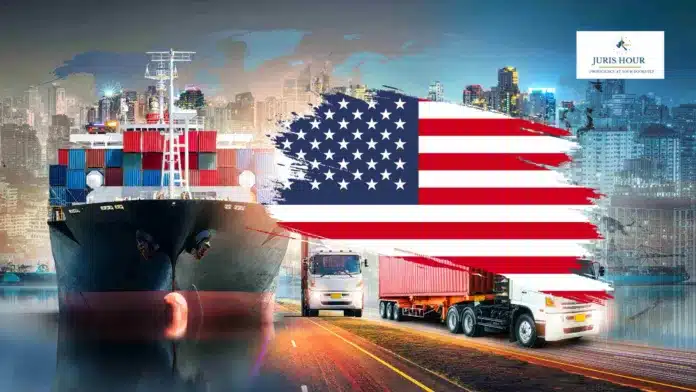President Donald Trump announced on April 9, 2025, a 90-day suspension of new tariffs for most nations, while escalating tariffs on Chinese imports to 125%, citing Beijing’s lack of respect and retaliatory measures.
The tariff pause maintains a general 10% tariff on imports, with exceptions such as vehicles facing a 25% rate. Goods from Mexico and Canada, covered under the USMCA, are excluded from these tariffs.
This decision follows appeals from over 75 countries and aims to alleviate recent financial market volatility, including concerns in the bond market. Despite earlier assertions of no delays, the unexpected reversal caught many off guard. Treasury Secretary Scott Bessent indicated that customized trade agreements could begin forming by June.
The move had immediate economic impacts:
- Market Reactions: Asian markets surged, with Chinese stocks gaining due to state-backed buying. U.S. stock futures showed mixed performance following a strong Wall Street rally.
- International Responses: China retaliated by raising tariffs on U.S. goods from 34% to 84% and vowed firm countermeasures. The European Union faces a 20% tariff, and the UK 10%.
- Political Reactions: Irish Tánaiste Simon Harris called for a “mature and rational debate,” emphasizing job protection and advocating for negotiations to resolve trade tensions.
In a dramatic move reshaping global trade, former President Donald Trump has imposed a 125% tariff on Chinese imports while pausing new tariffs for 90 days on most other countries. The announcement comes amidst mounting economic tension, stock market volatility, and increasing pressure from international allies.
What Did Donald Trump Announce About Tariffs in April 2025?
On April 9, 2025, Donald Trump unveiled a two-pronged trade policy. First, he paused additional tariff hikes on most countries for 90 days following appeals from over 75 governments. Second, he escalated tariffs on all Chinese imports from 60% to a staggering 125%, citing “disrespect from Beijing” and accusing China of “economic warfare.”
“They don’t respect us. It’s time we return the favor,” Trump said in a press briefing.
Which Countries Are Affected by the 90-Day Tariff Pause?
Most U.S. trading partners will benefit from the temporary tariff pause. Key highlights include:
- General 10% tariff remains for most imports.
- 25% tariff on vehicles still applies.
- Mexico and Canada are exempt under USMCA terms.
- European Union faces a 20% tariff.
- United Kingdom goods will see a 10% rate.
Why Did Trump Raise Tariffs on China to 125%?
According to Trump, the tariff hike is retaliation for China’s economic behavior, intellectual property violations, and what he termed a “weaponized trade imbalance.”
What Is China’s Response to the New Tariff Hike?
China swiftly announced countermeasures, increasing its tariffs on U.S. goods from 34% to 84% and vowing “firm and necessary” responses. This move has sparked concerns of an escalating trade war, reminiscent of Trump’s first term.
How Have Markets Reacted to the Tariff Announcement?
- Asian markets surged as Chinese investors expected state-backed stimulus.
- U.S. stock futures remained mixed following a volatile rally.
- Bond markets stabilized after a sharp selloff earlier in the week due to tariff fears.
What Are the Economic Implications of the 125% Tariff on China?
- U.S. importers may face increased costs, leading to higher consumer prices.
- Global supply chains could be disrupted, especially in technology and manufacturing sectors.
- Inflationary pressures may rise just as the Fed attempts to stabilize interest rates.
What Does the 90-Day Pause Mean for Global Trade?
This window opens up the possibility for customized bilateral trade agreements, which Treasury Secretary Scott Bessent said could begin rolling out by June 2025. Countries are now scrambling to engage with the U.S. trade team to protect their national interests.
Why Did Trump Pause Tariffs on Most Countries?
While initially adamant about immediate hikes, Trump likely paused tariffs due to:
- Financial market instability, including a 10% drop in the S&P 500.
- Backlash from American businesses, warning of supply chain disruptions.
- Diplomatic pressure from key allies like Japan, India, and the EU.
Is This Part of Trump’s “Art of the Deal” Strategy?
Analysts suggest this may be Trump’s negotiation tactic, creating pressure through extreme measures and then walking back selectively to extract concessions. Critics warn, however, that such unpredictability damages global investor confidence.
What Happens After 90 Days?
If no bilateral agreements are reached:
- The general 10% tariff could rise across the board.
- The U.S. may reintroduce blanket tariffs.
- Countries that fail to negotiate could face new trade restrictions.
What’s Next for U.S.-China Relations?
This high-stakes escalation deepens the U.S.-China trade conflict and sets the stage for potential global economic ripples. With world leaders urging diplomacy and industries bracing for impact, the next 90 days could redefine the future of international trade.
Read More: Interest On IGST Payment Is Beyond Customs Tariff Act, 1975: Bombay High Court





